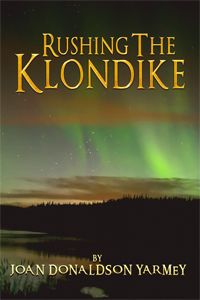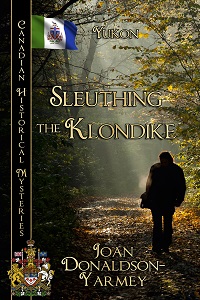The Vikings in North America
It has been long thought that the first European to
step on the soil of North America was Christopher Columbus. But excavations
done at a site in northwest Newfoundland, called L’Anse aux Meadows, in the
1960’s recovered artifacts like jewellery, a stone oil lamp, a bone knitting
needle, and tools that were compared to ones used at Viking settlements in
Greenland and Iceland around the year 1000. They have been carbon dated to
between the years 990 and 1050, proof that the Vikings were in North America
long before Columbus.
Vikings
were people from Scandinavia, present day Norway, Denmark, and Sweden, who were
merchants as well as warriors. During the late eighth to eleventh century they
raided, pillage, and conquered settlements in Scotland and throughout Europe.
They also had settlements in Iceland and Greenland.
Surnames ending in "-son" or
"-sen" are considered to have Viking ancestry. My great-grandparents emigrated from Scotland. Plus,
the little finger on my right hand does not lay flat when I set my palm down.
My sister has the same condition but worse. Her little finger had a permanent
bend to it. She went to her doctor and received a botox shot to relax it. When
she went for physio she was told that a bent finger like that was a sign of
being a Viking. I also have a friend of Norwegian ancestry with the same little
finger.
But, that
bent little finger comes from my mother’s side who also had one. Her maiden
name was Relf, which I learned was first found in the 1000s in Nairnit, a town in northern
Scotland. So, with this
ancestry on both sides I consider myself a Viking. In 2017, I visited L’Anse
aux Meadows in northwest Newfloundland.
From the parking lot I walked to the
interpretive centre where I looked at the displays of what the settlement would
have looked like during its occupation. There are replicas of the longships
that the Vikings sailed in, artifacts unearthed during the excavations,
write-ups about the Vikings, tools that were found, and maps showing the route
the Vikings used to get to Newfoundland or Vinland, as they are thought to have
named it. The Scandinavians of the medieval period were known as Norse and they
were farmers and traders. When they began raiding other countries they became
known as Vikings, the Norse word for raiders.
There has
been a lot of interest in the Vikings recently with televisions shows and
documentaries about them and their raiding which began in the 790s and lasted
until around 1050. With their longboats and advanced sailing and navigational
skills the Viking men and women travelled from Scandinavia south through Europe
to Africa, the Middle East, and Asia and west to North America.
I left
the centre and followed a long, wooden boardwalk through grass and small bushes
to the actual site. There I found a post fence around a yard with large mounds
covered in grass. When the Vikings landed here there were forests from which
they were able to get material for their boat and house building. The remains
of eight buildings were found in the 1960s and they are believed to have been
made of a wooden frame and covered with sod.
The
structures have been identified are a long house, an iron smithy, a carpentry
shop, and smaller buildings that may have been for lower-status crewmembers or
even slaves or for storage. There are three replicas of those sod buildings
with their thick walls on the site. One is a long house which is equipped with
clothes, beds and bedding, household utensils, tools, a fire pit and has a
couple dressed in period clothing cooking a meal. The Vikings hunted caribou,
bear, and smaller animals plus whale, walrus, and birds for food as well as
fished.
I
wandered through the rooms divided by hand carved wooden plank walls. Light
came from the fire and holes in the ceiling which are partially covered with
upside down wooden boxes to keep the rain out.
One of
the other buildings is the smithy complete with anvil, forge, bellows, and
various tools. I wandered the rest of the site and saw the outlines of other
buildings that have not been reconstructed. It is estimated that between 30 and
160 people lived there over the years.
The
Vikings arrived in Newfoundland from Iceland via Greenland. According to
historical records the site was inhabited by the brothers and sister of Leif
Ericson plus a series of explorers. It is believed the settlement was there for
seven or eight years before being abandoned. This is the only confirmed Viking
site in North America and is the farthest west that Europeans sailed before
Columbus.
After
viewing the buildings I followed a trail along the rocky shoreline and then
turned inland to walk on a boardwalk over a bog back to the parking lot.
One of
the best things is that not only does the interpretive centre have the history
of the Vikings, but there is also extensive displays showing the history of the
aboriginal people who inhabited the area over thousands of years before any
European arrived.
In 2018, I visited the Viking Ship Museum in Roskilde, just outside Copenhagen, Denmark. In the museum is a permanent exhibition of parts of five original Viking ships excavated nearby in 1962. A thousand years ago these ships were deliberately scuttled (filled with rocks and sunk) in a river to stop the enemy from invading the city by water. Over the decades since they were found, the pieces have been preserved and put together on a metal frame to show how the ships would have looked. Also at the site are replicas of the Viking ships and I became a Viking for an hour. A group of us sat on the seats and rowed the ship out of the harbour using the long oars. Once on the open water we hoisted the mast and set sail. After sailing for a while we headed back to the harbour. As we neared it I had the honour of pulling on the rope that lowered the mast and sail and we glided back to our dock.
It would
be fun, someday, to write a novel about my ancestors.


























